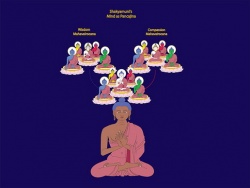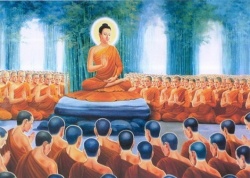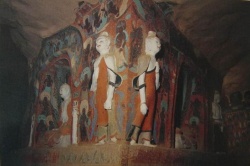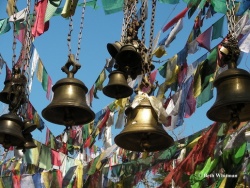The Amida Sutra:Translations & Commentaries
<poem>
Tradition says that the smaller Sukhavativyuha was translated into Chinese around 402 C.E. by Kumarajiva. Although the same tradition has it that there were three Chinese translations, only two remain. The other translation that remains is the Cheng-tsan ching-t'u-fo she-shou ching (T. 367), in one fascicle, done by Hsuan-tsang. Hsuan-tsang's translation is somewhat longer than Kumarajiva's and differs from it in some particulars. It appears to be based on a different Sanskrit original.1 There also is one extant Sanskrit version found in Japan. This Sanskrit version is thought to have been brought
to Japan by Ennin during the Heian period (794-1185). It was printed during the Edo period in 1773. In the west, F. Max Muller published an English translation of it in the Sacred Books of the East]] (Muller, 49:91-107 & 153-186). Of all the Pure Land manuscripts found at the Tun-huang site in China, Kumarajiva's translation of the A-mi-t'o ching is the most numerous; one hundred ninety copies of this work were discovered there. Only four manuscripts of Hsuan-tsang's translation were found at Tun-huang. This seems to be a strong indication that, of the two translations, Kumarajiva's was the more widely used. Shan-tao is said to have had a hundred thousand copies of this text transcribed during his lifetime.
In 1910 during the Meiji period (1868-1912), {{Otani Kozui]], Abbot of Nishi Honganji of the Jodoshin sect, sent the Otani mission to [[Wikipedia:Central Asia|Central Asia]]. This mission consisted of Tachibana Zuicho and Nomura Eizaburo. These two monks found a manuscript of the A-mi-t'o ching in Tulpan Province in western China. This manuscript carries a dedicatory inscription indicating that it was transcribed at Shan-tao's request (Tachibana). Commentaries written on the A-mi-t'o ching in China, Korea and Japan are too numerous to be named individually. Honen also wrote a commentary on the A-mi-t'o ching, called the Amidakyo shaku.
Basic Explanation of the Text:
The message of the A-mi-t'o ching is a simple one. It details a discourse of Shakyamuni to his disciple Shariputra about the Pure Land and the nembutsu. At the beginning of the sutra, Amida's Pure Land is said to lie ten trillion buddha lands to the West. Shakyamuni explains that Amida Buddha's Pure Land is known as "Perfect Bliss," because in contrast to this world of suffering, it is a land where there is only great joy. He describes the Pure Land as adorned with the seven kinds of precious metals and jewels on trees, in ponds, and on tall buildings. When the wind blows, wonderful music is heard. In such an environment, people naturally think of the Buddha, the Dharma and the Sangha. In short, the Pure Land combines all the features of an ideal world.
As for the name of the Buddha of this Pure Land, in Sanskrit, the word amita is referred to both as Amitabha ("Infinite light") and Amitayus ("Immeasurable life"). It is said there are no other original Sanskrit words for Amida Buddha other than Amitayus and Amitabha (Fujita, 304). Both are translated in Chinese as A-mi-t'o and in Japanese as Amida. This name also suggests the Buddha's limitless capacity to save all beings.
1. Nembutsu Practice
The sutra sets forth a simple method of salvation:
If a good man or woman hears about Amida Buddha and, with a single and undistracted mind, takes firm hold of his name, for one day, for two days or for three, four, five, six or seven days, then at the time when the person's life is about to end, Amida Buddha, together with the assembly of the many holy ones, will be present before that person. Such a person, with mind unperturbed at the moment of death, will attain birth in Amida Buddha's Land of Sukhavati.(T. 366, 12:347b)
Honen interpreted the expression "takes firm hold of his name" to mean the recitation of the nembutsu. For Honen, the recited nembutsu became the basis for reconciling the Sutra of Immeasurable Life's emphasis on the original vow with the Meditation Sutra's emphasis on contemplative practice. By reading the above passage of the Amida Sutra in this way, he was able to interpret it in light of the other two sutras. As the Amida Sutra is also very concise, Honen considered it to be the concluding sutra of the Jodosanbukyo.
2. Witness by the Buddhas of the Six Directions
The sutra next states, "Buddhas in all six directions, that is North, South East, West, Up and Down, all confirm that Amida Buddha's teaching is true."(T. 366, 12:347b-348a) Honen read this passage to mean that this sutra absolutely affirms that the nembutsu alone was the only assured way by which one can reach the Pure Land. (Senchakushu Chapt. 14)
Honen felt the main purport of the sutra consists of the buddhas of the six directions giving witness only to the practice of the nembutsu for gaining birth in the Pure Land and not giving witness to the various practices in other sutras regarding birth in the Pure Land. This he called senchaku shojo or “selection made by all buddhas of the six directions witnessing the authenticity of the nembutsu.” (Senchakushu Chapt. 14)
Honen's Eight Types of Selection (senchaku)
3. The Merit of the Nembutsu
Finally, this sutra declares that practitioners of the nembutsu receive two kinds of merit:
1) merit received in this life, by which they will be protected by all buddhas, and,
2) merit received in the next world after death, where they will be saved in the Pure Land. Honen felt that the Amida Sutra ends by recommending nembutsu recitation and a strong faith in it. (Senchakushu Chapt. 13)
For more on the Senchakushu
Notes:
For example, in the passage of the sutra where it says that many buddhas protect the teaching of the nembutsu practice, in Kumarajiva's version, the names of thirty-eight buddhas are given (T. 366, 12:347b-348a), whereas in Hsuan-tsang's version, the names of forty-two buddhas are given. (T. 367, 12:350a-c).
References:
Fujita Kotatsu, Genshi Jodo Shiso no kenkyu (Tokyo: Iwanami shoten, 1970).
F. Max Muller, “The Smaller Sukhavativyuha, Sacred Books of the East]]. & "On Sanskrit Texts Discovered in Japan", JRAS., 1880.
Tachibana Zuicho, Niraku Sosho, 1912.




